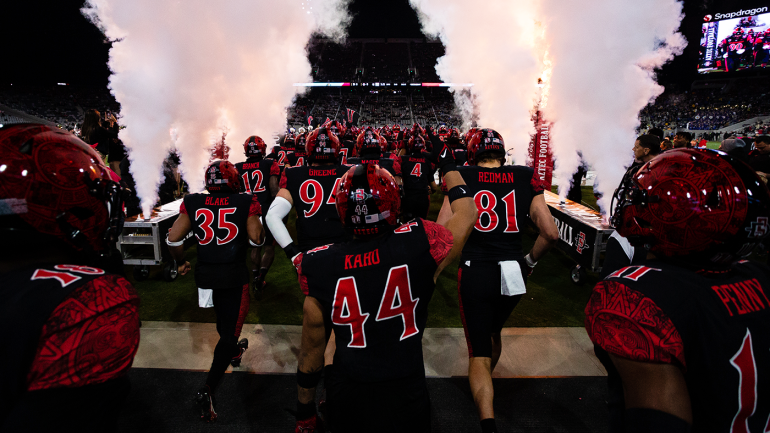
The question was asked this week regarding a turning point in conference realignment involving the Pac-12, San Diego State and college athletics: What happens Friday?
On June 30, the exit fee for the Aztecs to leave the Mountain West doubles from $17 million to $34 million. The technical deadline is 11 p.m. PT, but that doesn't exactly uncomplicate the picture.
San Diego State on June 13 wrote a letter to the MWC stating it ultimately intends to leave the conference, attempting to clarify through language in the letter that it was not yet submitting an official notice of withdrawal. As part of that letter, SDSU asked for a one-month extension on its deadline before the exit fee doubles so it could submit its official notice after June 30 and still only be on the hook for $17 million.
MWC commissioner Gloria Nevarez went out of her way in subsequent correspondence to not only deny the extension request but confirm that the conference accepted SDSU's initial, (thought to be) deftly worded letter as its official notice of withdrawal.
SDSU requesting an extension in its initial letter likely means it was told a Pac-12 media rights deal is probably another month away. Ideally, it wants to to make sure that deal is ratified before it submits an official notice of withdrawal.
However, the Aztecs can't afford not to leave the MWC considering the long-term trajectory of the university. Despite that, athletic director J.D. Wicker has publicly acknowledged his school cannot afford an doubled exit fee of $34 million.
Does SDSU have any leverage to get the MWC to agree to that one-month extension? Doesn't look like it.
"Technically, they're out of the conference right now," one source within the league said.
What if the Pac-12 doesn't call ... or perhaps even exist (unlikely, but the media rights number could come in low)? Would SDSU be welcomed back into the MWC? Does the Big 12 stand as a second option?
There have not been conversations between SDSU and the Big 12 in weeks, sources told CBS Sports. The Big 12 continues to prioritize Colorado and perhaps UConn with eyes on the other Four Corners schools in the Pac-12.
So, where are we in this latest realignment flashpoint?
The order of events hasn't changed. Nothing happens in the realignment big picture until the Pac-12 gets a new deal. As of July 1, there will be less than a year left before the current Pac-12 deal with ESPN and Fox expires.
Whether the Pac-12 stays in its current configuration continues to hinge on something CBS Sports pointed out long ago: The issue may be more about visibility than revenue.
That's why the likes of Colorado, Arizona and Arizona State are considering their options. The vast majority of the Pac-12 is waiting for the exact details of the new media rights deal before acting, though some have more options than others given the Big Ten does not appear keen on expanding again anytime soon.
After the new Pac-12 deal may come expansion. The new media partners could only offer a fixed figure only for the league's 10 teams. If there's less of a pie to go around, expansion may be squashed altogether. Is San Diego State worth a full share in any Power Five conference at this point? Wouldn't it settle for half a share in the Pac-12 -- say, $15 million per year -- just to get in the big time?
It still looks like Pac-12 or bust for SDSU, which begs the further question considering current events: What does bust look like?
At best, contentious negotiations are on the horizon over SDSU's exit. At worst, the two parties could end up in court.
Regardless of whether SDSU is deemed to be out of the league a year on June 30, 2024, the MWC intends to start withholding revenue. The school will not be able to join a new conference until July 1, 2024, but the huge debt (especially if it somehow increases from $17 million to $34 million) would impact its bottom line. SDSU would have to leave its share of NCAA Tournament units behind.
The MWC revised its bylaws two years ago to include a more punitive exit fee for any members who left before the end of the current media rights deal with CBS and Fox in 2026, according to the San Diego Union Tribune. That came about because the media rights partners are able to restructure the current deal should a team exit, meaning less money for the remaining members. The exit fee is meant to help compensate for some of that restructuring.
Ah, but everything is negotiable. If Texas and Oklahoma can leave the Big 12 a year early at a negotiated (but expensive) price, certainly something might be worked out here. Such issues have long been described this way: It is cheaper to negotiate an exit fee negotiations than go to court where legal fees can escalate quickly.
The MWC and SDSU seem to be squabbling over the term "intends to resign," which the Aztecs used in their initial letter. SDSU stated its notice would be "effective June 30, 2024, or at an agreed upon later date," hence the request for a one-month waiver and the subsequent denial from Nevarez.
A meeting of MWC ADs scheduled for Thursday was cancelled, according to sources. That meeting wasn't necessarily to issue some sort of edict but there does need to be some resolution to this matter.
SDSU is willing to ride out the current realignment tsunami because joining a Power Five conference is an unprecedented opportunity for the school. Its lawyers wanted to get on record it intends to leave. The Aztecs have a chance to step in for the departing USC and UCLA as the Southern California power still in a West Coast conference. More than that, they would grab that brass ring to the Power Five (as long as that designation lasts).
The Mountain West has not stood still. An expansion committee to address defections has long been in existence. So far, there have been no detailed meetings on potential replacements for San Diego State.
San Diego State officials hasn't spoken publicly in a while. However, in an interview with CBS Sports earlier this month before the letter went out, Wicker was asked the significance of June 30.
"It's an important date, but we've got [time] to assess all the options," Wicker said. "We can't afford to go from $18ish million to $36 million [in exit fees]. Going into the league in 2024, there would be some challenges with that."

















